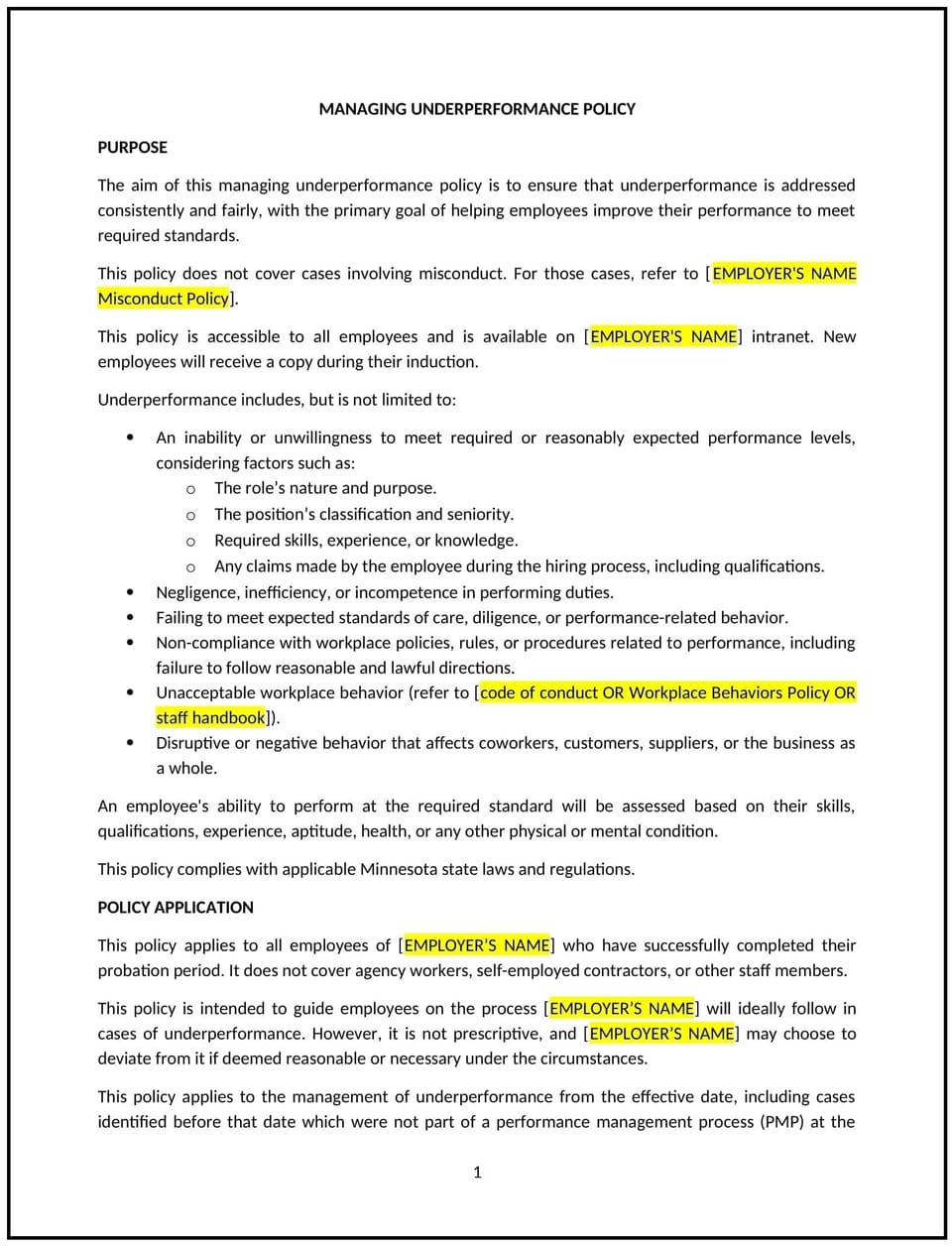Managing underperformance policy (Minnesota): Free template

Managing underperformance policy (Minnesota)
This managing underperformance policy is designed to help Minnesota businesses address employee performance issues in a fair, consistent, and constructive manner. It outlines the process for identifying underperformance, providing feedback, and taking corrective actions to support employees in improving their performance. The policy ensures that businesses maintain a productive work environment while supporting employees’ development and growth.
By implementing this policy, businesses can proactively address underperformance, improve employee engagement, and foster a culture of continuous improvement.
How to use this managing underperformance policy (Minnesota)
- Define underperformance: Clearly specify what constitutes underperformance within the organization, including examples related to job responsibilities, goals, and expectations.
- Outline the process for managing underperformance: Describe the steps involved in managing underperformance, starting with identifying performance issues, followed by providing feedback, offering support, and setting improvement targets.
- Provide a structured feedback process: Establish a procedure for managers to provide regular, constructive feedback, addressing specific performance issues and offering actionable suggestions for improvement.
- Offer support and development opportunities: Highlight the resources and support available to employees to help them improve, such as training, mentoring, or adjusting workloads.
- Set clear performance improvement plans: Define the process for creating and implementing a performance improvement plan (PIP), including timelines, measurable goals, and regular check-ins to track progress.
- Implement consequences for continued underperformance: Outline the steps that will be taken if the employee fails to meet performance expectations, which may include reassignment, demotion, or termination, depending on the severity of the underperformance.
- Encourage open communication: Foster an environment where employees feel comfortable discussing challenges they face, seeking feedback, and being transparent about potential performance issues.
Benefits of using a managing underperformance policy (Minnesota)
Implementing this policy provides several advantages for Minnesota businesses:
- Improves employee performance: By addressing underperformance early and offering support, businesses can help employees meet their potential and contribute more effectively to the organization.
- Boosts employee engagement: Clear expectations, constructive feedback, and opportunities for improvement can motivate employees to perform better and stay engaged in their work.
- Reduces turnover: Proactively managing underperformance can prevent dissatisfaction and frustration that may lead to turnover, as employees feel supported in their development.
- Ensures fairness: A structured approach to managing underperformance ensures that all employees are treated fairly, with consistent and transparent expectations and processes.
- Reflects Minnesota-specific considerations: Tailors the policy to Minnesota’s labor laws, ensuring it aligns with state regulations and best practices in managing performance issues.
Tips for using this managing underperformance policy (Minnesota)
- Communicate expectations clearly: Ensure that all employees understand the company’s performance standards and know how their performance will be evaluated.
- Provide regular feedback: Managers should give feedback regularly, not just during formal reviews, to address any issues early and maintain an ongoing dialogue about performance.
- Offer support and resources: Provide employees with the tools, training, and resources they need to improve, such as access to professional development programs or job aids.
- Address performance issues promptly: Don’t wait until underperformance becomes a bigger issue; address concerns early through regular check-ins or informal conversations.
- Review the policy regularly: Periodically review the policy to ensure it remains relevant, effective, and compliant with any changes to Minnesota state laws or company operations.
Q: What is considered underperformance?
A: Businesses should define underperformance based on job expectations, key performance indicators (KPIs), and specific objectives. Underperformance may include consistently missing deadlines, producing subpar work, or failing to meet established goals.
Q: How should managers address underperformance with employees?
A: Managers should approach underperformance with a supportive mindset. Start by having a private conversation to understand the root cause, provide specific feedback, and offer support. A plan for improvement should be developed, with clear expectations and timelines for progress.
Q: What should be included in a performance improvement plan (PIP)?
A: A performance improvement plan should outline specific areas of underperformance, measurable goals, and the steps the employee will take to improve. It should also specify the support the business will provide, such as training or mentoring, and set a timeline for improvement.
Q: How long should a performance improvement plan last?
A: The duration of a performance improvement plan will depend on the severity of the underperformance and the goals set. Typically, PIPs last from 30 to 90 days, with regular check-ins to monitor progress.
Q: What happens if an employee does not improve after a performance improvement plan?
A: If an employee fails to improve despite a performance improvement plan, businesses should follow the next steps, which could include reassignment, demotion, or termination, depending on the company’s policies and the situation.
Q: How can businesses encourage employees to take responsibility for their performance?
A: Businesses should create a culture of openness where employees are encouraged to set their own goals, seek feedback, and proactively address performance challenges. Open communication and support from managers are essential in encouraging accountability.
Q: Can performance issues be related to personal challenges?
A: Yes, personal challenges can impact performance. Businesses should foster a supportive environment where employees feel comfortable discussing challenges and seeking assistance. Managers should be empathetic and explore options for support, such as adjusting workloads or offering flexible hours.
Q: How often should this policy be reviewed?
A: The policy should be reviewed at least annually or whenever there are significant changes in company operations, Minnesota state laws, or performance management best practices to ensure it remains effective and aligned with business goals.
This article contains general legal information and does not contain legal advice. Cobrief is not a law firm or a substitute for an attorney or law firm. The law is complex and changes often. For legal advice, please ask a lawyer.


